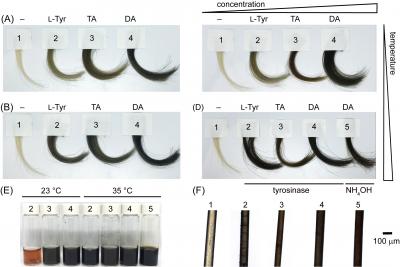Dye uses synthetic melanin to mimic natural hair pigmentation

Credit: Northwestern University
EVANSTON, Ill. — We’ve long been warned of the risks of dyeing hair at home and in salons. Products used can cause allergies and skin irritation — an estimated 1% of people have an allergy to dye. Furthermore, repeated use of some dyes has been linked to cancer.
But there soon may be a solution for the growing list of salons and hair color enthusiasts searching for natural alternatives to dyes and cosmetics.
Northwestern University researchers have developed a new way to create a spectrum of natural-looking hair colors, ranging from blond to black, by using enzymes to catalyze synthetic melanin.
The research will be published Oct. 30 in the journal Chemistry of Materials.
Melanin is an enigmatic and ubiquitous material often found in the form of brown or black pigment. Northwestern’s Nathan Gianneschi, the research lead and associate director for the International Institute for Nanotechnology, said every type of organism produces melanin, making it a readily available and versatile material to use in the lab.
“In humans, it’s in the back of our eye to help with vision, it’s in our skin to help with protecting skin cells from UV damage,” Gianneschi said. “But birds also use it as a spectacular color display — peacock feathers are made of melanin entirely.”
Gianneschi is the Jacob and Rosalind Cohn Professor of Chemistry in Northwestern’s Weinberg College of Arts and Sciences and a professor of materials science and engineering and biomedical engineering in the McCormick School of Engineering. Claudia Battistella, a postdoctoral fellow in Gianneschi’s lab, is the paper’s first author.
In the typical process of coloring hair, stylists use bleach to strip melanin from hair, then add ammonia and dye to open and penetrate the hair cuticles for permanent color. Work being done with melanin in other parts of the lab inspired Battistella to see how it applied to hair dye.
Battistella thought by replacing melanin instead of removing it and depositing color on the surface of hair instead of within it, she could create a more sustainable way to create lasting color. In this process, researchers dye hair by combining mushroom enzymes with an amino acid, causing a process that mimics reactions that naturally occur in the body. Preliminary studies revealed potential for the colored layer to persist through several washes.
“The dyeing process is similar from a stylist’s point of view, but these conditions are milder, so they take a little longer,” Battistella said. “Though it could be combined with a base, it’s not necessary to use one, and there is no need for chemical pigments. Because we already have melanin in our bodies, we believe we won’t have allergic reactions to it.”
Because melanin also fades in hair due to sun exposure and aging, researchers also wondered about the sun’s impact on the dye. Along with being a milder process than traditional dye, coating hair in synthetic melanin holds potential to protect hair from sun damage that can cause whitening. Studies showed that compared to untreated hair, hair treated with melanin pigment was damaged less when exposed to ultraviolet rays.
The paper identifies four key advantages to using synthetic melanin instead of traditional dyes:
- Synthetic melanin avoids the use of ammonia as a base layer.
- The precursors to treating hair with melanin are less toxic.
- The process uses safer, more scalable chemicals.
- There is vast potential in future cosmetic translations of synthetic melanin.
Given the industry’s desire to move away from carcinogens and other toxic chemicals, Gianneschi believes his lab will be able to break through the regulatory industry. The team then hopes to find a partner willing to develop the dye on a larger scale. From Gianneschi’s perspective, the main motivation for the research isn’t just excitement over melanin’s potentially vast commercial use.
“From a biomedical perspective, there’s a huge market of people with a hair dye allergy,” Gianneschi said. “Our first thought was it would be great to have a solution to help those people.”
###
Media Contact
Lila Reynolds
[email protected]




